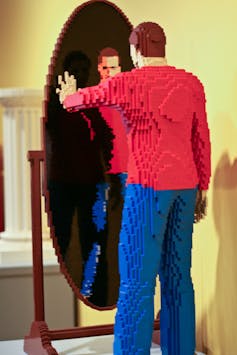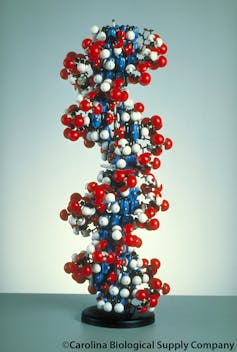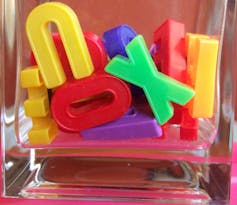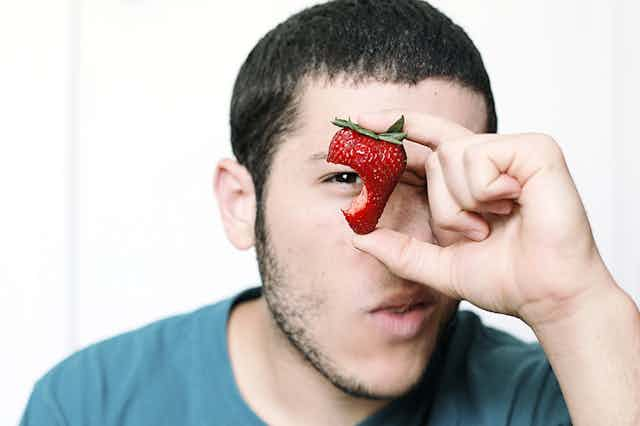Eating DNA sounds scary but it’s completely safe. I do it every day. Let me explain.
DNA stands for deoxyribonucleic acid. The words “acid” and “nucleic” are in the name so it is hardly surprising that some people are concerned about its effects when eaten.
But the name is nothing to worry about. While DNA is an acid, it’s a very weak one – more like vinegar, or the citric acid in lemons, than a dangerous acid like sulphuric acid.
What about the word “nucleic”? That has nothing to do with nuclear energy – it refers to the nucleus or centre of the living cell. The nucleus is the compartment where, in animals, plants and fungi, the DNA is stored. (In bacteria the DNA just floats around in the cell.)
The third part of the name – “deoxyribo” – also has a chemical sound to it but this just refers to ribose, which is a sugar a bit like glucose but with fewer carbons. The “deoxy” part means the ribose is missing one oxygen atom.
This makes DNA a very stable, non-reactive molecule and ideal for the long term storage of genetic information. It is also a good food.
Why am I so sure that eating DNA is safe?

I am sure because nearly all the food we eat contains DNA and lots of it. The reason is simple. Organisms are not built of continuous matter like plasticine, we are made up of tiny balloons called cells.
Ancient stories describe how people were fashioned from clay but actually it is more like being made of Lego blocks. Bacteria are single-celled organisms, most animals and plants are multi-celled organisms. Cats are bigger than mice because they have more cells.
In a sense, we are all like Lego constructions.
And here’s the amazing part – virtually every cell has its own DNA (its own genetic information or genome) and each cell in your body carries your genome. So each block is more like a smartphone than a balloon – each block has its own computer code or DNA genome.
In complex organisms each cell has the same DNA but interestingly different genes are active in different bodily organs. Think of genes as different apps on a smartphone – so all the smartphones that make up your liver will have one set of apps on, and your muscle cells will be using a different set of apps.
In plants, different apps (genes) are on in leaves and roots but all the cells of a plant carry the same set of genes, i.e. the same genome.
So whether you are a vegetarian who eats lettuce and cauliflower or an omnivore who eats steak and kidney pies, you are eating cells, and each cell contains DNA which in turn contains the entire genetic information or the whole genome of each species you eat.
The only living parts that don’t contain DNA are things like egg whites or filtered milk that are there for energy storage, or blood juices in which our blood cells float.

DNA is pushed out of hair when it forms so hair doesn’t have much – if any – DNA, but hair roots do, and in mammals red blood cells (but not white blood cells) push out their DNA as they mature so they can squeeze along tiny blood vessels.
But most parts of animals and plants are made up of cells containing DNA. This is why police can identify suspects from either a drop of blood or a hair root at a crime scene. They could also identify a lettuce or a strawberry from a leaf or from the fruit.
If you eat a three course meal – oysters for starters, chicken and asparagus as a main, and fruit salad for dessert, you are eating lots of different DNA.
Can DNA from food get into my own DNA?
Basically, DNA, like proteins and complex carbohydrates, gets broken down into pieces – this is what digestion is all about. Your teeth mash it up and enzymes throughout your digestive tract cut it to pieces.
Enzymes produced by your pancreas called DNases are specially designed to break the DNA into tiny pieces that can be taken up into your blood and then carried around and used by other cells to build new molecular structures in your body – including possibly your own DNA.
Could any of the genes, from any of the organisms you eat, get into your DNA and do you harm? It’s a reasonable question, but the answer seems to be no. Imagine you dropped a smartphone in a blender or ate it (please don’t) – all the components would be mashed up.

When you eat and digest DNA it seems that the long coding sequences, the narratives or the apps that specify gene products, are so cut up that they can no longer function as genetic material. There are few if any sentences left, just letters or fragments of words.
Even if some sentences did survive your digestive system it is unlikely they would enter your cells or harm you in any way.
Our world is awash with DNA and always has been but there is no clear evidence that eating DNA can harm you.
Genetically modified organisms
So what about genetically modified organisms or GMOs? Are they safe to eat too?
I certainly think so. If you ate a fish with a gene from a strawberry or a strawberry with a gene from a fish, to me it is no different from eating fish for the main course and strawberries for dessert.
I don’t think eating DNA or any combination of different DNAs from different species could do us harm.
To convince yourself that DNA is contained in food you can do a simple experiment at home. You can extract DNA from fresh strawberries.
I wouldn’t eat the DNA alone though. When wet it is slimy and when dry it looks like cotton wool. But when mixed with the other components of strawberries it is undetectable and harmless, and strawberries taste great as they are.

